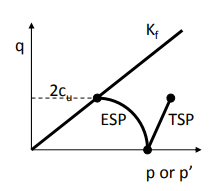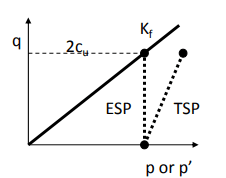Hey all:
Probably didn't phrase it properly![[surprise] [surprise] [surprise]](/data/assets/smilies/surprise.gif)
For a typical Triaxial test, is it possible to determine the shear strength of the entire soil layer lets say 5 meters homogeneous, just by sampling at different depth and interpret a "critical" value from the stress path?
Secondly, I'm trying to relate Mohr-Coulomb theory to the results obtained from Triaxial test; If I recall correctly, for a typical CU test on NC Clay, this should be the stress path:

But I'm quite confused when the MC model is mentioned, I mean shouldn't the result from CU test resemble MC theory already? How come a straight vertical stress path is deduced (which consequently overestimates shear strength):

Cheers
Probably didn't phrase it properly
![[surprise] [surprise] [surprise]](/data/assets/smilies/surprise.gif)
For a typical Triaxial test, is it possible to determine the shear strength of the entire soil layer lets say 5 meters homogeneous, just by sampling at different depth and interpret a "critical" value from the stress path?
Secondly, I'm trying to relate Mohr-Coulomb theory to the results obtained from Triaxial test; If I recall correctly, for a typical CU test on NC Clay, this should be the stress path:

But I'm quite confused when the MC model is mentioned, I mean shouldn't the result from CU test resemble MC theory already? How come a straight vertical stress path is deduced (which consequently overestimates shear strength):

Cheers
